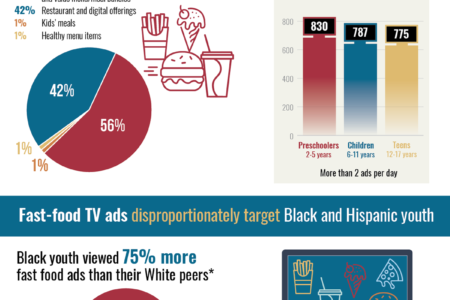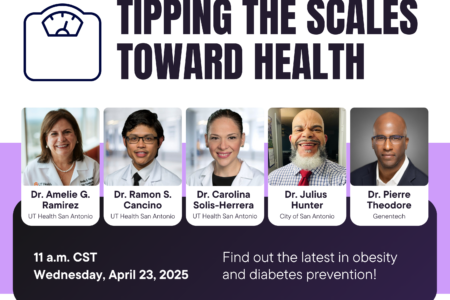
Share On Social!
Across the nation, people of color have less access to healthy, nutritious foods.
To super-size that unhealthy environment, the fast-food industry spent $5 billion on advertising in 2019, especially targeting Latino and Black youth, according to a new study from University of Connecticut’s Rudd Center for Food Policy & Obesity.
“Fast-food consumption by children and teens has increased over the past decade, and fast-food advertising definitely plays a role in that rise,” said Dr. Jennifer Harris, senior research advisor for marketing initiatives at the Rudd Center and a co-author of the study. “Our findings show that these advertisements disproportionately target Black and Latino youth, groups who already face greater risk for obesity and other diet-related diseases.
“Moreover, many fast-food companies tout recent introductions of healthier menu items as evidence of their commitment to improving nutrition, but they rarely promote these items in their advertising.”
The Fast Food Study and Its Findings
Fast Food FACTS 2021 analyzes advertising spending, TV advertising exposure, and targeted advertising for fast food to children, teens, and Black and Latino youth.
The Rudd Center’s 2010 & 2013 Fast Food FACTS reports documented the nutrition quality and marketing of fast food to youth. Using the same methods — Fast Food FACTS 2021 reveals how the fast-food advertising landscape has changed.
The new report finds that the industry’s annual ad spending in 2019 increased by over $400 million since 2012, and that children and teens were viewing on average more than two fast food TV ads per day.
Frequent and widespread exposure to fast-food marketing increases young people’s preferences for, and consumption of fast-food, which is largely high in calories, sugar, fat and sodium.
Fast-food represents 40% of all food and beverage marketing expenditures targeted at children and teens (aged 2- 17).
The study also found that:
- Children aged 2-5 viewed an average of 830 TV ads for fast food over the course of the year

- Children aged 6-11 viewed 787 ads over the course of the year
- Teens and tweens aged 12-17 viewed 775 ads over the course of the year
“Less time in front of TV screens is not protecting kids from fast-food TV ads,” said Dr. Frances Fleming Milici, director of marketing initiatives at the Rudd Center and a co-author of the study.
Concerning restaurant practices themselves, the study discovered that:
- The number of items on menus offered by McDonald’s, Subway, Burger King, and Taco Bell increased 35%
- Less than one-quarter of restaurants’ regular menu items qualified as nutritious options for teens
- Restaurants continued to offer large or extra-large soft drinks (350-850 calories) and large French fries (470-610 calories)
“Now more than ever parents need support in raising healthy children, and consistent exposure to ads featuring burgers, fries and pizza sabotages their best efforts. Media companies, policymakers and advocates can play a vital role in demanding an end to irresponsible advertising,” Milici said.
Latinos, Obesity, Fast-Food Consumption
The study found that Latinos and Blacks had a greater diet-related cancer burden when compared to their white counterparts.
An unhealthy diet is already a leading factor in causes of death, with more than 500,000 fatalities attributed to poor nutrition.
Sadly, fast food and corner stores outnumber supermarkets and farmers’ markets in many Latino neighborhoods, according to a Salud America! research review.
Latinos also tend to be a younger population with higher rates of obesity. Not only do they struggle with local access to healthy food, but also safe places to play.
Moreover, food insecurity is prevalent in the United States, especially in Latino and Black communities. 
U.S. Latino and Black households are more likely to suffer food insecurity (16.2% and 21.2%, respectively), which is being without reliable access to a sufficient quantity of nutritious food, than the national average (11.1%), according to USDA data, Salud America! reports.
COVID-19 is worsening food access, especially in Texas.
“Rates of food insecurity in November 2020 were still high for Texans across the board, but they were at least twice as high for Black (29%) and Hispanic (20%) adults as what white adults reported (12%) for households with children,” according to the report.
“Our results call for nutrition policies to address the U.S. cancer burden,” said the Rudd Center study authors, who proposed putting government-sponsored warning labels on red meats and other cancer-linked foods.
What Can I Do to Help Promote Healthier Food Environments?
Harris and the Rudd Center authors of the study recommend several steps fast-food restaurants can take to limit such unhealthy targeted marketing.
These include:
- Expanding voluntary industry self-regulation to restrict unhealthy food advertising to children up to age 14 at a minimum.
- Discontinuing ads for regular menu items on children’s TV channels.
- Ending disproportionately high marketing to Hispanic and Black youth.
They also offer suggestions for actions that federal, state and local governments can take, including: Creating nutrition standards for kids’ meals and eliminating unhealthy food and beverage marketing to children as a tax-deductible expense.
Lastly, their recommendations include how public health advocates and practitioners can push for changes to these marketing practices.
“Develop campaigns to increase public awareness of the vast amounts of primarily unhealthy fast-food advertising, especially advertising that disproportionately targets children, teens, and communities of color,” the Rudd Center report states. “Support youth-led countermarketing campaigns to expose marketing practices by the top fast-food advertisers.”
In the meantime, if you’d like to continue making a difference in your community’s nutrition—especially food insecurity—you can download a Salud America! Health Equity Report Card.
The report card will show you how many local children live in poverty and food deserts, how many have low food access, and how many get SNAP food benefits. Then you can compare it to your state and to the country.
Email your Health Equity Report Card to community leaders, share it on social media, and use it to make the case to address food insecurity where help is needed most!
Explore More:
Healthy FoodBy The Numbers
1
Supermarket
for every Latino neighborhood, compared to 3 for every non-Latino neighborhood



